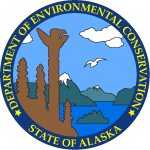| Action Date |
Action |
Description |
DEC Staff |
| 10/2/1992 |
Update or Other Action |
State Elmendorf Environmental Restoration Agreement (SERA) signed. The agreement is designed to remedy environmental contamination due to past practices at the Base and avoid the expense of formal enforcement proceedings. The Air Force will perform any necessary assessment, monitoring, remediation, and closure of the sites. The agreement addresses the following program areas: solid waste, underground storage tanks (USTs), and petroleum oil and lubricants (POL) spills |
Jennifer Roberts |
| 7/1/1994 |
Leaking Underground Storage Tank Release Confirmed - Petroleum |
LUST Site created in CSP for source area ID 77321 |
Former Staff |
| 7/1/1994 |
Leaking Underground Storage Tank Cleanup Initiated - Petroleum |
|
Former Staff |
| 7/1/1994 |
Site Added to Database |
|
Former Staff |
| 8/16/1994 |
Update or Other Action |
spill# 94-211-228-2 bldg. 43-575 hangar 12 South Side. Suspected JP-4 fuel, synthetic turbine oil, and hydraulic fluid. 110 cubic yards of contaminated soil. Seepage from old tanks being removed listed as cause of discharge. |
Louis Howard |
| 8/30/1994 |
Update or Other Action |
Three former regulated underground storage tanks (USTs) are associated with site ST407. A 500-gallon UST that stored used synthetic hydraulic oil was identified as Air Force Identification (AFID) number 575 and Alaska Department of Environmental Conservation (ADEC) number 181. AFID 576 / ADEC 182 was a 1,000-gallon UST that stored used synthetic turbine oil and AFID 578 / ADEC 184 was a 2,000-gallon UST that stored JP-4 fuel.
USTs were excavated and removed in 1994. Contamination was detected in 5 out of 10 confirmation samples with maximum concentrations of 9,000 milligrams per kilogram (mg/kg) diesel-range organics (DRO), 420 mg/kg gasoline-range organics (GRO), and 22.7 mg/kg total benzene, toluene, ethylbenzene, and total xylenes (BTEX). |
Louis Howard |
| 4/18/1995 |
Update or Other Action |
Air Force memo: 18 April 1995 Underground Storage Tank (UST) Meeting. Elmendorf AFB will accomplish the following actions regarding UST Projects. These actions are based upon conversation between, John Mahaffey, Larry Opperman and yourself (John Halverson-ADEC). EAFB will make every effort to accomplish a clean closure of a UST removal site if possible. UST removal locations requiring cleanup action will be transferred into the State-Elmendorf Environmental Restoration Agreement (SERA). A list of sites requiring cleanup will be coordinated with your office. The presumptive remedy for contaminated UST sites in the outwash plain only will be bioventing technology.
Contaminated soils exceeding cleanup levels may be placed back into the excavation only if the site assessment (SA) indicates a need for further cleanup action. Contaminated UST sites not in the outwash plain will require further investigation to determine appropriate cleanup options. We (the Air Force) will make every attempt possible to assure new USTs or new aboveground tanks are not installed in any way that would hamper future access for cleanup. The project will first accomplish removal of all of the USTs. Site Assessment (SA) information will be used to prioritize sites for cleanup using existing project funds. Additional funding will be requested to complete cleanup if available. Sites not addressed for cleanup due to exhausted funding will be placed into SERA Phase IV. John Halverson signed on April 21, 1995. Memo was signed by Douglas G. Tarbett, Maj, USAF, Chief, Environmental Compliance. CC: 3 WG/JA and 3 SPTG/CE. |
John Halverson |
| 9/30/1995 |
Underground Storage Tank Site Characterization or Assessment |
Underground Storage Tank Closure Assessment Del. Order 0006 Bldg. 43-574 and 43-575. Groundwater was not encountered in the tank excavations at Buildings 43-574 and 43-575. Records indicate that depth to groundwater at the nearest monitoring well on the base (Well GW-5A located roughly 250 feet NE of the USTs) was 42.7 feet in March 1994. TPH results were as high as 23,000 ppm in samples collected from around tank 578 and below the south end of tank 576. DRO results were as high as 9,000 ppm around tank 578. GRO results were as high as 420 ppm related to JP-4 dump receptacle and tank 575. BTEX results were as high as 22.7 ppm related to the JP-4 product piping between tank 575 and the dump receptacle. Based on the test results, additional site assessment and/or cleanup activities are needed at the tank site. The stockpiled soils were used to backfill the excavation without any treatment. |
Louis Howard |
| 12/8/1995 |
Update or Other Action |
Section 2.2.6 Page 2-11 It states soil and groundwater contamination were identified durign closure of the UST and that soil matrix level B applies. If releases at the site have impacted groundwater, matrix cleanup level A applies, rather than level B. It also states that former USTs contained synthetic hydraulic oil, synthetic turbine oil, and JP-4. It is not clear whether bioventing is an appropriate remedial technolgy to address synthetic hydraulic oil and turbine oil. |
Louis Howard |
| 10/17/1996 |
Institutional Control Record Established |
Air Force memo: Restricted Use of the Shallow Aquifer on EAFB signed by William R. Hanson P.E. GM-14 Chief Environmental Flight dated October 17, 1996 Memorandum for 3 SPTG/CEC/CEO from 3 SPTG/CEV
1) Due to the contamination & commitments to EPA/DEC the use of the shallow aquifer for any purpose on is not allowed. Attached Facilities Board minutes-03/29/1994 0930 Item 9 has Mr. William Hanson, briefing the Board on the policy to not use the shallow aquifer due to contamination. The Board approved this policy. Minutes approved by Thomas R. Case Brigadier General USAF Commander. The IRP has RODs for OUs 3 & 6 which require, the aquifer remain unused. 2) Personnel in the review process within CES must be aware of these policies & review them on a recurring basis. It is imperative this restriction be recognized & observed during engineer reviews & operations. |
Louis Howard |
| 3/31/1997 |
Update or Other Action |
The ST407 release investigation was conducted in June 1996. The surface above the former
tank locations at ST407 was unpaved at the time of the release investigation, and was
surrounded by concrete and covered by gravel. Three corrugated, perforated drain pipes are
installed in the site area. No significant surface stains were observed. The former USTs
location was determined by the gravel area and the UST removal coordinates.
Six borings were completed at ST407, including one bioventing air injection well (407WL01),
four soil gas monitoring arrays (407PZ01 through 407PZ04), and one boring that was grouted
following installation (407BH01). Groundwater was encountered at approximately 42 feet bgs. Site soils consist of sand and gravel typical to the Elmendorf outwash plain. Soil samples contained elevated ATH/PID readings and smelled of petroleum hydrocarbons from all samples collected from boring 407WL01. For this reason analytical results were compared to ADEC Level A cleanup standards Field screening results for
petroleum hydrocarbons were negative for all other borings.
Soil petroleum hydrocarbon analytical results are summarized on Table 3-1 and Figure 3-1 and
fully reported in Appendix C. Soil contamination above ADEC Level A cleanup standards was
detected in 3 of the 12 normal soil samples collected at ST 407, with maximum concentrations
of450 mg/Kg RRO, 2600 mg/Kg DRO, 257 mg/Kg GRO, 0.15 mg/Kg benzene, and 3.55 mg/Kg
total BTEX. Chromatograms were not conclusive, but were indicative of weathered middle
distillates. |
Louis Howard |
| 6/3/1998 |
Update or Other Action |
Letter from ADEC to Air Force (J. Mahaffey)- RE: Corrective Action for SERA Phase IV Sites. The Alaska Department of Environmental Conservation (Department) has reviewed the release investigations reports received in March of 1997 by the Air Force as part of the SERA IV Release Investigation Project. Based on information contained in the release investigation and previously submitted site assessment reports, the Department requests the Air Force to begin correction action on contaminated soils associated with decommissioned underground storage tanks (UST) at the following sites:
1. ST 401; AFIDs 96-104 associated with Building # 22-013,
2. ST 402; AFID 150, associated with Building # 32-127,
3. ST 403; AFIDs 209 & 229, associated with Building # 22-009,
4. ST 422; AFID 471, associated with Building # 41-701,
5. ST 424; AFID 189, associated with Building # 32-189,
6. ST 405; AFID 335, associated with Building 42-335,
7. ST 419; AFIDs 51 & 52, associated with Building # 41-659,
8. ST 407; AFIDs 575, 576 & 578, associated with Building # 43-575,
9. ST 410; AFID 165, associated with Building “Hush House”,
10. ST 421; AFID 425A, B, C & D, associated with Building # 42-425, and
11. ST 428; AFID130, associated with Building # 1-836.
SERA IV sites not listed above may need further release investigation work, or the contamination may be low enough to justify a “no further action” response.
Since all the SERA IV sites listed above have soil contamination that extends to ground water, and groundwater sampling was not performed as part of the SERA IV release investigations, the Department is assuming the groundwater is also contaminated. The Department is requesting the Air Force to submit a corrective action plan to address the contaminated groundwater, or submit a groundwater sampling plan to find the extent of groundwater contamination associated with the decommissioned UST. |
Tim Stevens |
| 6/28/2001 |
Offsite Soil or Groundwater Disposal Approved |
ST407 POL Contaminated soil removal action request approved. Air Force proposes to remove contaminated soil and transport to Alaska Soil Recycling for thermal treatment and disposal or return of treated soil back to Elemendorf for disposal. |
Louis Howard |
| 7/31/2001 |
Leaking Underground Storage Tank Corrective Action Underway |
Corrective Action Plan Eleven SERA IV Sites Final Revision 1 received. Bioventing study was performed during the 1996 release investigation. This study was conducted to establish whether bioventing would be suitable for remediation of POL-Contaminated soils. Results indicated that oxygen levels were not depleted, a condition unfavorable for bioventing. Presumptive remedy for shallow and deep contamination is: excavation up to 15 ft. bgs and groundwater monitoring. Bioventing will not be done since the testing showed that it is not favorable. A review of the existing wells at the Base revealed that an adequate groundwater monitoring well network does not currently exist in the vicinity of ST407; wells will likely need to be installed in this vicinity to adequately monitor the impact of site contamination. It is proposed that the wells be sampled as part of the Basewide Environmental Monitoring Program to monitor any potential impact the soil may have on groundwater. |
Louis Howard |
| 1/31/2002 |
Update or Other Action |
ST407 Removal Action Report received. Soil excavation was initiated at SERA monitoring well 407WL01, where the highest contamination levels were detected during the SERA investigation, and based on visible staining and PID field screening. A total of 73.5 tons of soil was excavated and transported to ASR for soil treatment. Treated soils were returned to EAFB municipal solid waste landfill closure site in November 2001. DRO levels were found to be 972 mg/kg from the east sidewall near the floor of the excavation.
In summary, contaminated soil has been excavated to the maximum extent practical to a depth of between 15 and 18 feet bgs. DRO contaminated soil above the Method Two cleanup level remains at 16 feet bgs and likely extends to the smear zone at 41 feet bgs in the location of the former USTs (The smear zone is defined as the range of depths within which the groundwater will fluctuate under normal seasonal conditions, and therefore, in which free product would move and “smear” the soil in response to these seasonal changes in the water level elevation. The smear zone soils may therefore be saturated or unsaturated with groundwater at any given time.) |
Louis Howard |
| 7/28/2002 |
Update or Other Action |
ADEC (CS Program S. Bainbridge, Leslie Pearson PER Program) and Air Force (Daniel Barnett) signed the Operational Agreement (OA) concerning presumptive remedies for cleanup of certain petroleum oil and lubricant releases on the outwash plain portion of Elmendorf AFB, Alaska. This OA establishes and describes pre-approved presumptive remedies but does not establish an exclusive set of cleanup options and nothing in the memorandum prohibits EAFB from seeking or obtainin ADEC approval to implement alternative release response and remedial action plans.
For new POL spills in the outwash plain that occur in areas with no operational restrictions or interference from surrounding structures, ADEC approves immediate remediation of contaminated media after free product has been recovered in a manner that minimizes the spread of contamination into an uncontaminated area by using containment, recovery, disposal techniques appropriate to site conditions. The presumptive remedy for new POL spills on the outwash plain consist of excavation, treatment, and disposal of all impacted soil.
On a case-by-case basis, ADEC will evaluated the need for recovery of free product from the water table. Finally groundwater monitoring and Ics placed on the shallow aquifer restricting its use as a drinking water source will be required until such a time that the appropriate groundwater remedial goals are met. If additional institutional controls are required, these controls will be developed by EAFB in consultation with ADEC.
The OA does not apply to spills impacting surface waters. Nothing in the OA relieves, extends or changes the applicable requirements of 18 AAC 75 and 78 for the proper treatment, storage or disposal of contaminated media that result from the implementation of this OA. |
Louis Howard |
| 10/21/2002 |
Update or Other Action |
Letter sent to Joe Williamson dissolving the State Elmendorf Environmental Restoration Agreement. The Alaska Department of Environmental Conservation (DEC) has reviewed the issue of abolishing the State Elmendorf Environmental Restoration Agreement (SERA) per your recommendation. Elmendorf Air Force Base and DEC entered into the SERA in 1992. The agreement was developed as a tool to bring the Base into compliance with Alaska's regulations addressing underground storage tanks, oil and other hazardous substance releases and solid waste.
Since that time, Elmendorf has made significant progress in investigating and cleaning up historic contamination problems. Many of the sites covered by the SERA have been successfully cleaned up and closed. Cleanup is underway at the remaining sites.
Additionally, Alaska has amended the regulations addressing fuel storage tanks, oil and other hazardous substance spills and solid waste. We concur with you that the SERA is no longer a necessary or beneficial. This letter serves as notice that DEC will end oversight on environmental work at Elmendorf by using the SERA. Instead, it is understood that the sites and programs formerly addressed by SERA: solid waste, underground storage tanks (UST), and oil and other hazardous substance discharges will be addressed in accordance with 18 AAC 60, 18 AAC 78 and 18 AAC 75. |
Louis Howard |
| 7/19/2004 |
Conditional Closure Approved |
After reviewing the data and reports submitted for ST407, the Department agrees that no additional remediation or investigation is required for ST407 LUST Event ID 1826. However, groundwater monitoring will be required until cleanup levels are achieved.
The Department reserves its rights, under: 18 AAC 75 Contaminated Site regulations, 18 AAC 78 Underground Storage Tank regulations, and AS 46.03 to require additional investigation, cleanup, containment, and/or other necessary actions, if subsequent information indicates: additional contamination remains at the site which was previously undiscovered and presents an unacceptable risk to human health, safety, or welfare, or the environment. |
Louis Howard |
| 7/19/2004 |
Long Term Monitoring Established |
The selected remedy for this site is monitored natural attenuation. This remedy was selected for site ST407 because contamination remains at 16 feet bgs and in the smear zone at site ST407. Remaining contaminant concentrations exceed the ADEC 18 AAC 75 (January 2003) cleanup levels at this site. Contaminated soil was excavated to the maximum extent practicable.
This site is located within the OU5 modeling area as identified in the Operational Agreement (OA) between ADEC and Elmendorf AFB signed 28 July 2002. In the OA, both parties agree that the portion of the unconfined shallow aquifer in the outwash plain has demonstrated, through modeling and sampling, the ability to naturally attenuate residual hydrocarbon contamination from most petroleum, oil, and lubricant (POL) spills in a reasonable period of time.
The Elmendorf AFB Basewide Groundwater Monitoring Program will be utilized to monitor the natural attenuation of the impacted groundwater. The nearest downgradient monitoring well is OU4W-04, located approximately 3,600 feet to the southwest and 64-WL-01, located approximately 4,800 feet to the south. |
Louis Howard |
| 2/18/2005 |
Update or Other Action |
February 18, 2005 list of sites sent which includes ST407. Well IDs OU4MW-04 and 64WL-01 will be sampled on a biannual basis for DRO. Each well presented in the table submitted will be sampled in 2005 to establish baseline COC concentrations. Proposed sampling frequencies would thus take effect in 2006. An annual sampline frequency has been assigned to sites near the OU5 Bluff whereas all other sites received a biannual frequency. |
Louis Howard |
| 7/6/2006 |
Update or Other Action |
2005 Annual Report Monitored Natural Attenuation of Basewide Compliance Program Wells received. Currently, the 3 CES/CEVQ is required by ADEC to monitor the degree to which certain regulated contaminants are naturally attenuating on 27 sites throughout the Base. The natural attenuation of each of these sites is being monitored by sampling and analyzing the groundwater under the contaminated areas and/or downgradient of the contaminated source.
In 1996, concentrations of DRO remained within the smear zone at ST407 that exceeds the 18 AAC 75 cleanup level. In 2005, groundwater at monitoring wells OU4MW-04 and 64WL-01, both hydraulically downgradient of ST407, had detectable concentrations of DRO, but concentrations were below the cleanup level found in 18 AAC 75.345 Table C. |
Louis Howard |
| 5/20/2009 |
Update or Other Action |
The 2006 Conceptual Site Model Reviews Report recommended installing and sampling a new in-source and a new downgradient well to monitor ST407. However, the report also discussed construction of a new C-17 maintenance hangar directly over the ST407 source area. According to the 2006 Annual Report, vadose zone soil samples were recommended to be collected as soon as possible (pending construction activities) to determine if DRO concentrations in soil continue to exceed the cleanup level. In addition, a new monitoring well was recommended as close to location of the former USTs as possible for analytical sampling.
The locations for installation of the new wells were checked during the summer of 2006 and
again in 2007 and 2008. It was determined that construction activities still interfered with
installation of any new monitoring wells for 2008 and they will need to be installed at a later
date. |
Louis Howard |
| 5/28/2009 |
Update or Other Action |
Draft 2008 Annual Report, Compliance Program Elmendorf AFB May 11, 2009 reviewed and commented on by staff. 6.2 ST407 Conclusions and Recommendations Page 6-3: ADEC concurs with the recommendations to collect soil samples as soon as possible to detennine if DRO concentrations in soil continue to exceed cleanup levels and install a monitoring well as close to the location of the fonner underground storage tanks (USTs) as possible for groundwater sampling. |
Louis Howard |
| 4/15/2010 |
Cleanup Complete Determination Issued |
2009 Annual Report Monitoring of Compliance Program Sites, Elmendorf Air Force Base (EAFB) dated March 2010 reviewed by staff.
6.3 ST407 Conclusions and Recommendations Page 6-3
ADEC concurs with the recommendation ST407 be given a cleanup complete designation. In accordance with 18 AAC 75.380, after reviewing the monitoring report submitted under this section, ADEC has determined that ST407 (CS DB Hazard ID 2032) has been adequately characterized under 18 AAC 75.335 and has achieved the applicable requirements under the site cleanup rules This will serve as ADEC’s written determination that the cleanup is complete, subject to a future ADEC determination that the cleanup is not protective of human health, safety, or welfare, or of the environment.
|
Louis Howard |
| 6/17/2013 |
Exposure Tracking Model Ranking |
Initial ranking with ETM completed for source area id: 77321 name: autogenerated pm edit - Elmendorf - ST 407 AFID 575, 576 and 578 |
Louis Howard |
| 3/29/2016 |
Institutional Control Record Removed |
Institutional Controls have been removed. |
Louis Howard |
| 3/22/2017 |
Long Term Monitoring Workplan or Report Review |
2016 Draft Report for Remedial Action Operation and Land Use/Institutional Control at JBER received for review and comment. Due to the remaining smear zone contamination, groundwater use restrictions will remain in place at the site. The use of the shallow aquifer for any purpose is not allowed. As long as hazardous substances remain at levels that preclude unrestricted use, groundwater development and the use of groundwater for any purpose including but not limited to drinking, irrigation, fire control, dust control, or any activity is prohibited in the shallow aquifer south of the Elmendorf Moraine. Remaining residual contamination in groundwater and the vadose zone is below regulatory standards, and site closure with institutional controls is appropriate and protective of human health and the environment. In accordance with State of Alaska regulation 18 AAC 75, the USAF has completed cleanup activities at SO549. Analytical results indicate vadose zone soil contamination levels are below ADEC 18 AAC 75.341 Method Two, Tables B1 and B2 Under 40-Inch Zone, Migration to Groundwater cleanup levels and groundwater contamination levels are below ADEC 18 AAC 75.345 Table C cleanup levels. DRO contamination remains in smear zone soils above the ADEC 18 AAC 75.341 Method Two, Table B2 Under 40-Inch Zone, Migration to Groundwater cleanup level, and groundwater use restrictions will remain in place at the site. ADEC’s review and concurrence on the request for Cleanup Complete with ICs status is required in accordance with State of Alaska environmental conservation laws and regulations (ADEC 2017). The inspection of Site SO549 revealed no evidence of ground disturbance at this site. Revegetation did not appear to be occurring and the monitoring wells located at the site were observed to be in good condition. Site inspection photographs at Site SO549 could not be collected due to the level of security at the site, however no evidence was observed that would require site maintenance or repair. See site file for additional information. |
Ginna Quesada |
| 6/25/2024 |
Long Term Monitoring Workplan or Report Review |
DEC approved the 2023 Annual Remedial Action-operations And Long-term Management Report for Select State-regulated Sites Final, dated June 2024. The report describes the site inspections, maintenance activities, and groundwater monitoring, at multiple sites located on Joint Base Elmendorf- Richardson (JBER), Anchorage, Alaska. Site inspections were recommended to continue for all sites to ensure that conditions remain protective of human health and the environment. The report recommends updating land use controls (LUC) boundaries at CG534, a ‘Cleanup Complete’ determination without institutional controls (ICs) for SS522, the removal of groundwater LUCs at SS041, and a Cleanup Complete with ICs determination for TU101. |
Ginna Quesada |
| 5/6/2025 |
Long Term Monitoring Workplan or Report Review |
DEC approved the 2024 Annual Remedial Action-Operations and Long-Term Management Report for Select State-Regulated Sites Final, dated May 2025. The report describes the site inspections, maintenance activities, and groundwater monitoring, at multiple sites located on Joint Base Elmendorf- Richardson (JBER), Anchorage, Alaska. Site inspections were recommended to continue for the majority of the sites to ensure that conditions remain protective of human health and the environment. DEC concurs with the recommendation to close SS522 site without ICs, discontinue groundwater sampling at TU107, and reducing the sampling frequency for some wells at TU103. |
Ginna Quesada |




